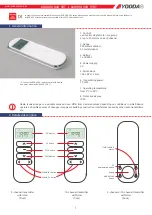
SuperPro Series Installation Manual
HUB
Central Distribution point or connectivity device. A hub resembles the “hub” of a wheel.
The networks peripherals are connected by cabling that resembles the “spokes” of a
wheel. The Distribution Panel utilizes “input” and “output” hubs for coax, twisted pair,
and fiber optic distribution and connectivity.
HVAC
Heating, Ventilating and Air Conditioning.
IEEE
Institute of Electrical and Electronics Engineers. A professional engineering society.
Impedance
The opposition that a circuit or component offers to the flow of electric charge. It is
expressed in ohms and is equal to the following ratio: Effective Value of Voltage
Applied to the Circuit / Resulting Current. In AC circuits, the impedance is a complex
quantity that includes both resistance and reactance. In DC circuits it is purely resistive.
Index of
Refraction
The ratio of light velocity in a vacuum to its velocity in a given transmitting medium.
Information
Superhighway
A network of information accessible to anyone, anywhere. The commonly known
superhighway is known as the Internet. The Internet is a compilation of thousands of
computers linked together, worldwide. Almost any information available can be found
on the Internet.
Input
A signal (or power) that is applied to a piece of electric apparatus, or the terminals of
the apparatus to which a signal or power is applied.
Insertion Loss
The attenuation caused by adding a component; in other words, a connector or coupler
in an optical transmission system.
IRBus
CEBus acronym for the Infrared Signal Bus.
ISDN
DISDN
Integrated Services Digital Network - A CCITT standard, currently under development,
that will cover a wide range of data communication issues but primarily the total
integration of voice and data.
Kilometer
One thousand meters or 3,281 feet. The kilometer is a unit of measurement for signal
paths.
KSU
Key Service Unit - Commercial Telephone System.
LASER
Light Amplification by Stimulated Emission of Radiation. A device which produces
coherent light with a narrow range of wavelengths.
LED
Light Emitting Diode - A device used in a transmitter to convert information from electric
to optical form. It typically has a large spectral width.
Light
In the laser and optical communication fields, the portion of the electromagnetic
spectrum that can be handled by the basic optical techniques used for the visible
spectrum extending from the near ultraviolet region of approximately 0.3 micron,
through the visible region and into the mid-infrared region of about 30 microns.
Lightwaves
Electromagnetic waves in the region of optical frequencies. The term “light” was
originally restricted to radiation visible to the human eye, with wavelengths between
400 and 700 nanometers (nm). However, it has become customary to refer to radiation
in the spectral regions adjacent to visible light (in the near infrared from 700 to about
2000 nm) as “light” to emphasize the physical and technical characteristics they have in
common with visible light.
Macrobending
Large axial deviations of a fiber from a straight line relative to the axial dimensions of
the fiber, such as pulling the fiber around a corner.
Media Link
Electronics communications protocol and chipset designed to use fiber optics as the
media. Used today mostly for Professional Audio.
Megahertz
(MHz) A unit of frequency that is equal to one million Cycles per second.
Microbending
Curvatures of fiber that involve axial displacements of a few micrometers and spatial
wavelengths of a few millimeters, such as displacements caused by stress during the
cable making process. Microbends cause loss of light and consequently increase the
Page 36
FutureSmart































